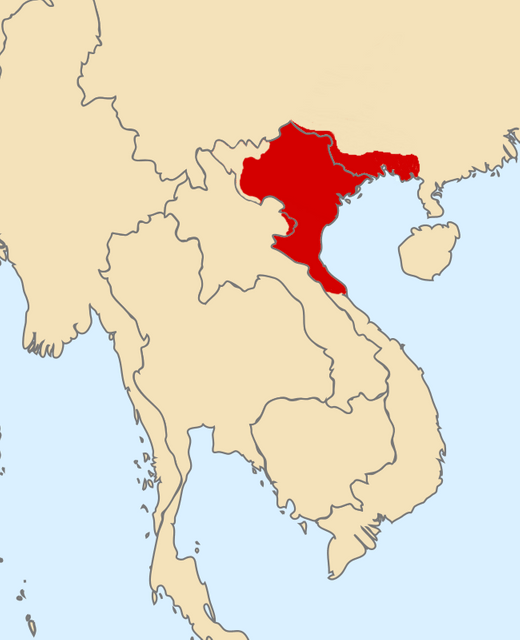Early Lý dynasty

Early Lý dynasty

Kingdom of Vạn Xuân Vạn Xuân Quốc (萬春國) | |||||||||
|---|---|---|---|---|---|---|---|---|---|
| 544–602 | |||||||||
| Status | Empire | ||||||||
| Capital | ToLich River(544-548) Long Uyên (550-602) | ||||||||
| Common languages | Old Vietnamese | ||||||||
| Religion | Buddhism | ||||||||
| Government | Monarchy | ||||||||
| King | |||||||||
• 544–548 | Lý Nam Đế (First) | ||||||||
• 548–571 | Triệu Việt Vương (Middle) | ||||||||
• 571-602 | Hậu Lý Nam Đế (Last) | ||||||||
| History | |||||||||
• Lý Bí revolt against Liang dynasty | 543 | ||||||||
• Lý Bí proclaimed himself king | 544 | ||||||||
• Political crisis in Lý dynasty | 509 | ||||||||
• Surrender of Hậu Lý Nam Đế | 602 | ||||||||
| Currency | Cash coins | ||||||||
| |||||||||
| Today part of | Vietnam China | ||||||||
The Early, Former or Anterior Lý dynasty (Vietnamese: nhà Tiền Lý) was a dynasty which ruled Vietnam from AD 544 to 602. Its founder Lý Bí assumed the title of "Southern Emperor" (Lý Nam Đế). The realm of the Early Lý was known as Vạn Xuân ("Myriad Spring") and their capital was at Long Biên within modern Hanoi.
Kingdom of Vạn Xuân Vạn Xuân Quốc (萬春國) | |||||||||
|---|---|---|---|---|---|---|---|---|---|
| 544–602 | |||||||||
| Status | Empire | ||||||||
| Capital | ToLich River(544-548) Long Uyên (550-602) | ||||||||
| Common languages | Old Vietnamese | ||||||||
| Religion | Buddhism | ||||||||
| Government | Monarchy | ||||||||
| King | |||||||||
• 544–548 | Lý Nam Đế (First) | ||||||||
• 548–571 | Triệu Việt Vương (Middle) | ||||||||
• 571-602 | Hậu Lý Nam Đế (Last) | ||||||||
| History | |||||||||
• Lý Bí revolt against Liang dynasty | 543 | ||||||||
• Lý Bí proclaimed himself king | 544 | ||||||||
• Political crisis in Lý dynasty | 509 | ||||||||
• Surrender of Hậu Lý Nam Đế | 602 | ||||||||
| Currency | Cash coins | ||||||||
| |||||||||
| Today part of | Vietnam China | ||||||||
Lý Bí and the establishment of Kingdom of Vạn Xuân
History
Lý Bí (503–548) was born in Thái Bình,(Sơn Tây). In 543, he and his brother Lý Thiên Bảo revolted against the Chinese Liang dynasty to gain Vietnamese independence. Many reasons are given for the motive of his revolt, among them the fact that he was a member of a wealthy family and, having failed an imperial examination, decided to revolt.
Kingdom of Vạn Xuân
In 544, Lý Bí defeated the Liang dynasty, proclaimed himself emperor and named the country Vạn Xuân. At this time, he built the Trấn Quốc Pagoda in Hanoi.
Political resistance
The sixth century was an important stage in the Vietnamese political evolution toward independence. During this period, the Vietnamese aristocracy, while retaining Chinese political and cultural forms, grew increasingly independent of China. At the same time, indigenous leaders arose who claimed power based on Vietnamese traditions of kingship. A series of failed revolts in the late sixth and early seventh centuries fueled the Vietnamese national consciousness. Lý Bí, the dynasty's founder, was himself descended from a Chinese family that had fled to the Red River Delta during a period of dynastic turbulence in the first century A.D.[1][2][3][4][5][6][7][8][9][10] Lý Bí declared himself emperor of Nam Việt in the tradition of Triệu Đà and organized an imperial court at Long Biên.[11] Lý Bí was killed in 547, but his followers kept the revolt alive for another fifty years, establishing what is sometimes referred to in Vietnamese history as the Earlier Lý Dynasty.
While the Lý family retreated to the mountains and attempted to rule in the style of their Chinese overlords, a rebel leader who based his rule on an indigenous form of kingship arose in the Red River Delta. Triệu Quang Phục made his headquarters on an island in a vast swamp.[12] From this refuge, he could strike without warning, seizing supplies from the Liang army and then slipping back into the labyrinthine channels of the swamp. Despite the initial success of such guerrilla tactics, by which he gained control over the Red River Delta, Triệu Quang Phục was defeated by 570. According to a much later Vietnamese revolutionary, General Võ Nguyên Giáp, Vietnamese concepts of protracted warfare were born in the surprise offensives, night attacks, and hit-and-run tactics employed by Triệu Quang Phục.
Sui–Lý War
When the internal conflict of Lý dynasty became uncontrolled, Emperor Wen of Sui started the campaign of invading Vạn Xuân. The king of Vạn Xuân (Lý Phật Tử) surrendered to the Sui, marking the beginning of renewed Chinese domination in Vietnam.